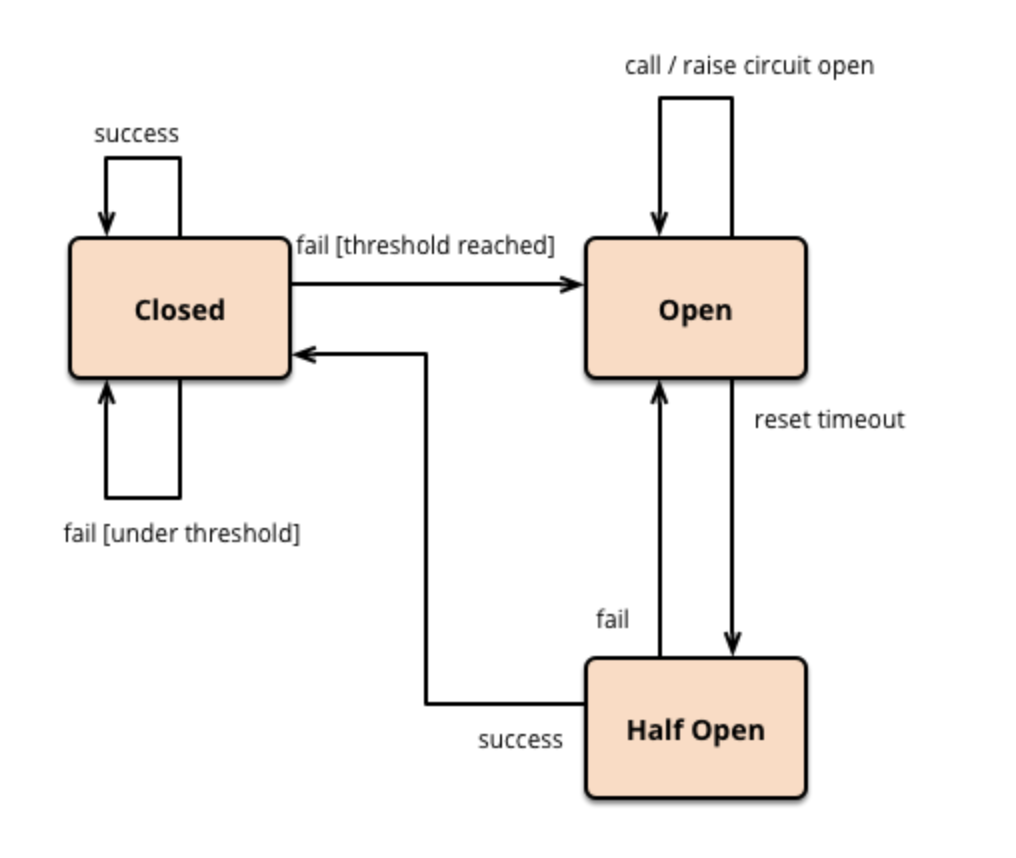Ganesha is PHP implementation of Circuit Breaker pattern which has multi strategies to avoid cascading failures and supports various storages to record statistics.
If Ganesha is saving your service from system failures, please consider donating to this project's author, Akihito Nakano, to show your ❤️ and support. Thanks you!

This is one of the Circuit Breaker implementation in PHP which has been actively developed and production ready - well-tested and well-documented. 💪 You can integrate Ganesha to your existing code base easily as Ganesha provides just simple interfaces and Guzzle Middleware behaves transparency.
If you have an idea about enhancement, bugfix..., please let me know via Issues. ✨
- Ganesha
- Table of contents
- Are you interested?
- Unveil Ganesha
- Usage
- Strategies
- Adapters
- Ganesha ❤️ Guzzle
- Ganesha ❤️ OpenAPI Generator
- Run tests
- Companies using Ganesha 🚀
- Build promotion site with Soushi
- Requirements
- Author
Here is an example which shows you how Ganesha behaves when a failure occurs.
It is easily executable. All you need is Docker.
# Install Composer
$ curl -sS https://getcomposer.org/installer | php
# Run the Composer command to install the latest version of Ganesha
$ php composer.phar require ackintosh/ganeshaGanesha provides following simple interfaces. Each method receives a string (named $service in example) to identify the service. $service will be the service name of the API, the endpoint name or etc. Please remember that Ganesha detects system failure for each $service.
$ganesha->isAvailable($service);
$ganesha->success($service);
$ganesha->failure($service);$ganesha = Ackintosh\Ganesha\Builder::build([
'failureRateThreshold' => 50,
'adapter' => new Ackintosh\Ganesha\Storage\Adapter\Redis($redis),
]);
$service = 'external_api';
if (!$ganesha->isAvailable($service)) {
die('external api is not available');
}
try {
echo \Api::send($request)->getBody();
$ganesha->success($service);
} catch (\Api\RequestTimedOutException $e) {
// If an error occurred, it must be recorded as failure.
$ganesha->failure($service);
die($e->getMessage());
}(martinfowler.com : CircuitBreaker)
Ganesha follows the states and transitions described in the article faithfully. $ganesha->isAvailable() returns true if the circuit states on Closed, otherwise it returns false.
- When the circuit state transitions to
Openthe eventGanesha::EVENT_TRIPPEDis triggered - When the state back to
Closedthe eventGanesha::EVENT_CALMED_DOWNis triggered
$ganesha->subscribe(function ($event, $service, $message) {
switch ($event) {
case Ganesha::EVENT_TRIPPED:
\YourMonitoringSystem::warn(
"Ganesha has tripped! It seems that a failure has occurred in {$service}. {$message}."
);
break;
case Ganesha::EVENT_CALMED_DOWN:
\YourMonitoringSystem::info(
"The failure in {$service} seems to have calmed down :). {$message}."
);
break;
case Ganesha::EVENT_STORAGE_ERROR:
\YourMonitoringSystem::error($message);
break;
default:
break;
}
});If disabled, Ganesha keeps to record success/failure statistics, but Ganesha doesn't trip even if the failures reached to a threshold.
// Ganesha with Count strategy(threshold `3`).
// $ganesha = ...
// Disable
Ackintosh\Ganesha::disable();
// Although the failure is recorded to storage,
$ganesha->failure($service);
$ganesha->failure($service);
$ganesha->failure($service);
// Ganesha does not trip and Ganesha::isAvailable() returns true.
var_dump($ganesha->isAvailable($service));
// bool(true)Resets the statistics saved in a storage.
$ganesha = Ackintosh\Ganesha\Builder::build([
// ...
]);
$ganesha->reset();Ganesha has two strategies which avoids cascading failures.
$ganesha = Ackintosh\Ganesha\Builder::build([
'timeWindow' => 30,
'failureRateThreshold' => 50,
'minimumRequests' => 10,
'intervalToHalfOpen' => 5,
'adapter' => new Ackintosh\Ganesha\Storage\Adapter\Memcached($memcached),
]);If you want use Count strategy, use Builder::buildWithCountStrategy().
$ganesha = Ackintosh\Ganesha\Builder::buildWithCountStrategy([
'failureCountThreshold' => 100,
'intervalToHalfOpen' => 5,
'adapter' => new Ackintosh\Ganesha\Storage\Adapter\Memcached($memcached),
]);Redis adapter requires phpredis. So if you don't have it, run pecl install redis.
$redis = new \Redis();
$redis->connect('localhost');
$adapter = new Ackintosh\Ganesha\Storage\Adapter\Redis($redis);
$ganesha = Ackintosh\Ganesha\Builder::build([
'adapter' => $adapter,
]);Memcached adapter requires memcached (NOT memcache) extension.
$memcached = new \Memcached();
$memcached->addServer('localhost', 11211);
$adapter = new Ackintosh\Ganesha\Storage\Adapter\Memcached($memcached);
$ganesha = Ackintosh\Ganesha\Builder::build([
'adapter' => $adapter,
]);MongoDB adapter requires mongodb extension.
$manager = new \MongoDB\Driver\Manager('mongodb://localhost:27017/');
$adapter = new Ackintosh\Ganesha\Storage\Adapter\MongoDB($manager);
$configuration = new Configuration(['dbName' => 'ganesha', 'collectionName' => 'ganeshaCollection']);
$adapter->setConfiguration($configuration);
$ganesha = Ackintosh\Ganesha\Builder::build([
'adapter' => $adapter,
]);If you using Guzzle (v6 or higher), Guzzle Middleware powered by Ganesha makes it easy to integrate Circuit Breaker to your existing code base.
use Ackintosh\Ganesha\Builder;
use Ackintosh\Ganesha\GuzzleMiddleware;
use Ackintosh\Ganesha\Exception\RejectedException;
use GuzzleHttp\Client;
use GuzzleHttp\HandlerStack;
$ganesha = Builder::build([
'timeWindow' => 30,
'failureRateThreshold' => 50,
'minimumRequests' => 10,
'intervalToHalfOpen' => 5,
'adapter' => $adapter,
]);
$middleware = new GuzzleMiddleware($ganesha);
$handlers = HandlerStack::create();
$handlers->push($middleware);
$client = new Client(['handler' => $handlers]);
try {
$client->get('http://api.example.com/awesome_resource');
} catch (RejectedException $e) {
// If the circuit breaker is open, RejectedException will be thrown.
}As documented in Usage, Ganesha detects failures for each $service. Below, We will show you how Guzzle Middleware determine $service and how we specify $service explicitly.
By default, the host name is used as $service.
// In the example above, `api.example.com` is used as `$service`.
$client->get('http://api.example.com/awesome_resource');You can also specify $service via a option passed to client, or request header. If both are specified, the option value takes precedence.
// via constructor argument
$client = new Client([
'handler' => $handlers,
// 'ganesha.service_name' is defined as ServiceNameExtractor::OPTION_KEY
'ganesha.service_name' => 'specified_service_name',
]);
// via request method argument
$client->get(
'http://api.example.com/awesome_resource',
[
'ganesha.service_name' => 'specified_service_name',
]
);
// via request header
$request = new Request(
'GET',
'http://api.example.com/awesome_resource',
[
// 'X-Ganesha-Service-Name' is defined as ServiceNameExtractor::HEADER_NAME
'X-Ganesha-Service-Name' => 'specified_service_name'
]
);
$client->send($request);Alternatively, you can apply your own rules by implementing a class that implements the ServiceNameExtractorInterface.
use Ackintosh\Ganesha\GuzzleMiddleware\ServiceNameExtractorInterface;
use Psr\Http\Message\RequestInterface;
class SampleExtractor implements ServiceNameExtractorInterface
{
/**
* @override
*/
public function extract(RequestInterface $request, array $requestOptions)
{
// We treat the combination of host name and HTTP method name as $service.
return $request->getUri()->getHost() . '_' . $request->getMethod();
}
}
// ---
$ganesha = Builder::build([
// ...
]);
$middleware = new GuzzleMiddleware(
$ganesha,
// Pass the extractor as an argument of GuzzleMiddleware constructor.
new SampleExtractor()
);PHP client generated by OpenAPI Generator is using Guzzle as HTTP client and as we mentioned as Ganesha ❤️ Guzzle, Guzzle Middleware powered by Ganesha is ready. So it is easily possible to integrate Ganesha and the PHP client generated by OpenAPI Generator in a smart way as below.
// For details on how to build middleware please see https://github.com/ackintosh/ganesha#ganesha-heart-guzzle
$middleware = new GuzzleMiddleware($ganesha);
// Set the middleware to HTTP client.
$handlers = HandlerStack::create();
$handlers->push($middleware);
$client = new Client(['handler' => $handlers]);
// Just pass the HTTP client to the constructor of API class.
$api = new PetApi($client);
try {
// Ganesha is working in the shadows! The result of api call is monitored by Ganesha.
$api->getPetById(123);
} catch (RejectedException $e) {
awesomeErrorHandling($e);
}We can run unit tests on Docker container, so it is not necessary to install dependencies in your machine.
# Start redis, memcached server
$ docker-compose up
# Run tests in container
$ docker-compose run --rm -w /tmp/ganesha -u ganesha client vendor/bin/phpunitHere are some companies using Ganesha in production. To add your company to the list, please visit README.md and click on the icon to edit the page.
https://ackintosh.github.io/ganesha/
The promotion site is built with Soushi, which is the site generator powered by PHP.
$ docker-compose run --rm client soushi build docs
# The site will be generate into `docs` directory and let's confirm your changes.
$ open docs/index.htmlGanesha supports PHP 5.6 or higher.
Ganesha © ackintosh, Released under the MIT License.
Authored and maintained by ackintosh
GitHub @ackintosh / Twitter @NAKANO_Akihito / Blog (ja)



